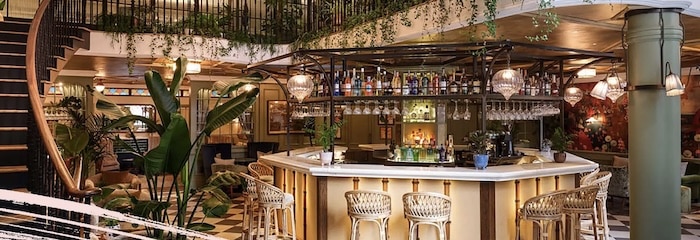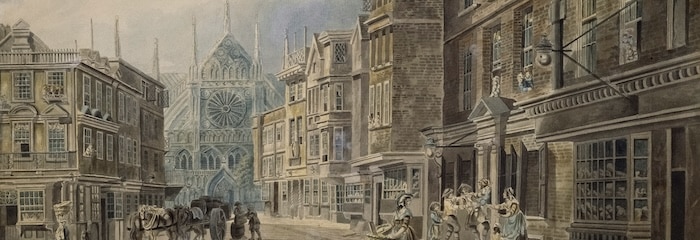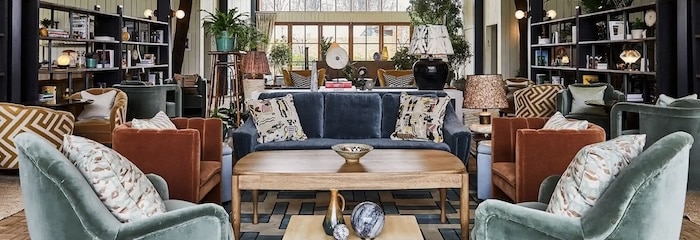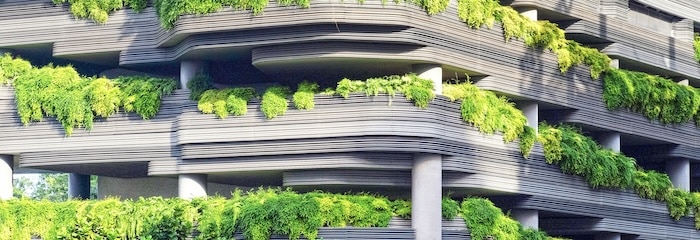The History of Private Members’ Clubs in London
June 20, 2025 Capital A List - Celebrity club news

The history of private members’ clubs in London is a tale of evolution, exclusivity, and adaptation, reflecting the broader societal changes over the centuries. These clubs have been a microcosm of London’s social stratification, political affiliations, and changing cultural norms from their origins to the present day.
Here, we will explore the origin of private member clubs since their first days as coffee shops. We’ll delve into the creation of female member clubs and how modern society shapes these exclusive environments to become more inclusive and accessible to the general population.
Back in the Day: Coffee Houses and the First Clubs
It all kicked off in the 17th century, but not in the way you might expect.
Let’s turn the clock back even further. Here, we soak in the ambience of London’s coffee houses and the very genesis of private members’ clubs. This period is where our modern notion of networking, socialising, and even doing business over coffee (or tea) began to take shape.
The Coffee House Craze
Imagine London in the 17th century. A bustling, expanding city with the aroma of roasted coffee beans beginning to waft through its streets. Coffee houses first sprang up in the mid-1600s. By the 18th century, they were the beating heart of London’s social and intellectual life. These were not just places to enjoy a hot beverage; they were the original social networks. They were deep in political debate, business transactions, and literary discourse.
Coffee houses were the go-to places for news and information, predating the widespread availability of newspapers. They were hubs of gossip, rumour, and the occasional enlightened discussion frequented by writers, philosophers, politicians, and anyone who could afford the entry price—a penny, which often included access to newspapers and stimulating conversation.
From Coffee to Clubs
The transition from coffee houses to private members’ clubs was natural and inevitable. Private members’ clubs were planted as the social elite sought exclusive settings. They were free from the popular coffee houses’ harsh noise and crowded conditions. The emerging clubs offered elevated privacy, exclusivity, and comfort, becoming homes away from home for their distinguished members.

White’s, which started as one of these coffee houses, evolved into the private members’ club prototype. Established in 1693, White’s became known for its high-stakes gambling and notable membership, setting the standard for the following clubs.
Boodle’s and Brooks’s were similarly exclusive, catering to specific political or social groups. Boodle’s, known for its association with the Conservative Party, and Brooks’s, aligned with the Whigs, underscored how these spaces were not just about leisure but were pivotal in the political and social discourse of the time.
The Culture of Clubs
These early clubs were soaked in tradition and ritual, with strict rules and customs governing membership and behaviour. The nomination and election process ensured that only those deemed suitable by existing members could join. It preserved the clubs’ exclusive nature. Once inside, members enjoyed the luxury and comfort of the club’s facilities and the privilege of being part of a select community. They were bound by shared values, interests, and, often, socio-political goals.
A Reflection of Society
The evolution from coffee houses to private members’ clubs mirrored the changing social landscape of London. As the city grew wealthier and more diverse, these clubs provided a sanctuary for the elite to preserve their social networks, conduct business, and retreat from public life. They were a microcosm of London’s stratified society, reflecting and reinforcing the social hierarchies of the day.
A Scene of Their Own: The Rise of Women’s Clubs
So, the late 19th and early 20th centuries were buzzing with change. Women were making their voices heard more than ever before, and amidst all this social turmoil, they started carving out spaces for themselves in the form of private members’ clubs. These weren’t just any spaces; they were plush, exclusive spots where women of a certain independence and strength of mind could gather.

Women’s Clubs were close to the luxury shopping streets of Bond Street, Regent Street, and Oxford Street. Places like the Alexandra, Pioneer, Bath Club, and the Empress became the go-to haunts for women who weren’t just about the tea and chatter. They offered a blend of luxury and a forward-thinking spirit, where women could attend lectures, partake in educational programs, and even indulge in a smoking room if the mood struck.
More Than Just Socializing
But it wasn’t just about creating a female version of the men’s clubs. These women’s clubs had layers about empowerment, education, and carving out a niche in a society that was still pretty rigid about gender roles. They mirrored the grandeur of their male counterparts while pushing the envelope on what it meant to be a space for women. In a way, they were revolutionary, providing a haven for “strong-minded, independent women” and serving as a platform for social and educational advancement.
The Times, They Are Changing
Fast-forward a bit, and the landscape began to shift. The staunchly male bastions of private clubs had to reckon with the changing times post-WWI and WWII. Women weren’t just knocking on the doors but kicking them down. Major clubs began to admit women as guests and, eventually, as full members, marking a significant shift in the private club scene. Yet, some clubs held onto their men-only policies, a nod to tradition in a rapidly evolving social landscape.
The Evolution: Keeping Up with the Times
Let’s dive into the juicy evolution of London’s private members’ clubs in the modern era. It’s a story of adaptation, innovation, and a little “out with the old, in with the new,” but not entirely.
A Modern Makeover
By the time the 21st century rolled around, private members’ clubs in London began to feel the pressure to modernise, to shake off the dust of elbow patches. The goal? Stay relevant in a city that’s constantly reinventing itself.

These clubs started to morph into spaces about exclusivity and offering a unique, contemporary experience. Their goal was to become appealing to the new generation of movers and shakers, from millionaires to newly affluent millennials seeking something different from the traditional club vibe.
The New Club Experience
Imagine walking into a club that feels like a step into the future but with a nod to the classic charm. These places now offer everything from modern gyms and luxury spas to dining experiences crafted by top chefs.
And it’s not just about leisure anymore. The lines between work and play are blurred, with clubs providing dedicated workspaces for the digital nomads among us, complete with high-speed internet and coffee on tap. Networking doesn’t just happen in stuffy boardrooms anymore; it’s all about the casual bump-ins at the club.
The Social Scene Gets a Facelift
The social aspects of these clubs have also seen a major overhaul. We’re talking full exhibitions, lectures, concerts, and more programs. Dress codes? Those have been relaxed, too. Smart jeans and trainers are often the norm now, reflecting a broader societal shift towards casualisation in previously formal settings.
Enter the New Players
And then there are the newcomers, clubs that have challenged the notion of what a private members’ club can be. Take The House of St Barnabas, which transformed a former homeless shelter into a club with a cause, funnelling its profits into social programs.

Or Soho House, the poster child of the club world’s expansion, morphing from a single house in 1995 to a global empire with branches worldwide. Each branch is tailored to the local vibe but united by the brand’s ethos of luxury and exclusivity.
The Future Is Now
What’s clear is that the private members’ clubs of London are no longer just about exclusivity based on social status or wealth; they’re about offering something unique that resonates with their members’ identities and needs. They’re spaces that blend the old with the new, tradition with innovation, and in doing so, they continue to write new chapters in the long history of London’s social scene.
What’s in Store?
As we look to the horizon, the future of London’s private members’ clubs appears bright and intriguingly unpredictable. These institutions now blend the richness of their past with the ever-changing landscape of modern life.
Adapting to the Digital Age
In an increasingly digital world, clubs are embracing technology as a tool for administration and as a core aspect of the member experience. From apps that allow for easy booking of rooms and events to virtual networking platforms fostering connections beyond physical spaces, technology is reshaping how members interact with their clubs and each other.
The challenge and opportunity lie in balancing this digital integration with the personal, intimate experience at the heart of the club ethos.
Sustainability and Social Responsibility
As societal values shift towards greater environmental consciousness and social responsibility, clubs are also pivoting. Initiatives ranging from sustainable dining practices to support for charitable causes reflect a broader trend of clubs seeking to contribute positively to the community and the world.

The House of St Barnabas is a prime example of using its platform to support social programs. This trend will likely deepen, with members increasingly drawn to clubs that reflect their values and offer a sense of purpose.
Expanding the Definition of Exclusivity
The concept of exclusivity is evolving. While traditional clubs may have prioritised social status or wealth, the new age of clubs recognises exclusivity in diversity, innovation, and unique experiences.
This could mean clubs catering to specific professional interests, lifestyle choices, or cultural pursuits, offering a tailored experience that draws members for prestige and personal or professional growth opportunities.
A Global Club Experience
Following the model set by entities like Soho House, the future may see more clubs expanding to offer a global experience, where membership in one club opens doors worldwide. This reflects a growing global mobility among the professional and affluent classes, who seek the familiarity of their club experience even when abroad. Such networks could redefine the club concept from a singular location to a global community.
The Challenge of Remaining Relevant
The greatest challenge for clubs moving forward is to remain relevant and appealing across generations. This involves adapting to changing tastes and expectations and actively anticipating and shaping them.
Clubs that balance honouring their heritage and embracing change will likely thrive. They will become dynamic spaces that continue attracting diverse and engaged membership.
The History of Private Members’ Clubs in London
The history of private members’ clubs in London is truly fascinating.
London’s social clubs have evolved remarkably from the humble beginnings of the 17th-century coffee houses to today’s sophisticated, diverse private members’ clubs. These institutions have transitioned from exclusive enclaves for the elite to dynamic spaces that reflect the city’s changing social, political, and cultural landscape.

Starting as vibrant hubs for debate and networking in coffee houses, these social spaces laid the groundwork for what would become the private members’ clubs. Establishments like White’s, Boodle’s, and Brooks’s emerged, epitomising exclusivity and setting a precedent for future clubs. As society evolved, so did the role of women. This led to the founding of ladies’ clubs in the late 19th and early 20th centuries. It challenged the male-dominated status quo and provided a space for empowerment and social advancement.
The late 20th and early 21st centuries marked a significant shift. Now, clubs are diversifying their offerings to cater to a broader, more inclusive membership. Contemporary clubs blend their predecessors’ luxurious and opulent traditions with modern amenities, reflecting the 21st-century culture. Today, these clubs serve as multifunctional spaces where leisure, work, and social networking intersect. This makes them more appealing to a new generation of members.
Looking ahead, the trajectory of London’s private members’ clubs suggests a continuous adaptation to the digital age. It also shows a deeper commitment to sustainability and social responsibility and an ever-expanding definition of exclusivity. As these clubs navigate the challenges of remaining relevant while honouring their heritage, they promise to remain integral to London’s social life.
Read more Continue Reading →Grey Wolfe Member’s Club London Review: Exclusive Wellness Sanctuary
April 2, 2025 Capital A List - Celebrity club news

Grey Wolfe Member’s Club in London is a beacon of holistic wellness and rejuvenation. Established in 2021, Grey Wolfe has transitioned from a pay-as-you-go wellness destination to an exclusive private members’ club as of January 2024. This evolution focuses on personalized and immersive wellness experiences, blending advanced biotechnology with time-honoured holistic practices.
The club’s design philosophy centres on creating a tranquil haven that fosters solitude and self-reflection. The interior has minimalist elegance, with natural materials such as stone and wood, complemented by warm lighting. This thoughtful design promotes a calming atmosphere, reducing stress and fatigue on both neurological and biological levels.
A distinctive aspect of Grey Wolfe is its dedication to privacy and exclusivity. Members are granted sole access to the entire facility during their booked sessions. This ensures an uninterrupted and deeply personal wellness journey. This unique approach allows individuals to disconnect from the external chaos and engage in meaningful self-care.
Grey Wolfe Member’s Club London Membership and Amenities
Grey Wolfe offers a range of membership tiers, each designed to cater to diverse wellness objectives. While specific pricing details are available upon request, the club provides the following membership options:
- Quartz Membership: Ideal for those seeking comprehensive wellness immersion, with unlimited access to the club’s facilities, including unrestricted BioTech treatments and a monthly 60-minute hands-on therapy session. Members also receive a luxury welcome box, quarterly wellness mapping kits, personalized check-ups, and the option to bring a guest during visits.
- Citrine Membership: For individuals desiring weekday access. It includes unlimited use of BioTech treatments and a monthly 60-minute hands-on therapy session.
- Amethyst Membership: For weekend wellness seekers, this tier provides weekend access to the club, 50 BioTech treatments annually, and a monthly 30-minute hands-on therapy session.
- Obsidian Membership: Suited for those with demanding schedules, this membership grants 12 visits per year, each encompassing a BioTech treatment, facilitating consistent wellness engagement without extensive time commitments.
- Corporate Membership: Focused on organizational wellness, this option offers tailored programs to enhance employee well-being, including mental health support, nutritional coaching, and stress management workshops.
To become a member, submit an inquiry through Grey Wolfe’s official website. This process initiates a personalized consultation to assess individual wellness goals and determine the most suitable membership tier.
Grey Wolfe’s amenities are thoughtfully curated to provide a holistic and transformative experience. The BioTech Treatments have cutting-edge technologies, including the Infrared Sauna, which utilizes gentle heat to promote deep detoxification and relaxation; the BioCharger, designed to enhance cellular function and energy levels; and the Hyperbaric Oxygen Pod, aimed at boosting immune function and reducing inflammation.
A selection of personalized treatments such as lymphatic drainage, sports massage, and pregnancy massage are available, each conducted by experienced practitioners to address specific needs and promote overall well-being. Regular one-on-one sessions provide members with tailored guidance on nutrition, mindfulness, and lifestyle adjustments, ensuring health and longevity.
Grey Wolfe Member’s Club London Cuisine, Dress Code & Address
Fees: Grey Wolfe offers a range of membership tiers, each designed to cater to diverse wellness objectives.
Dress Code: Sportswear
Area: Putney
Address: 71 White Hart Ln, London SW13 0PP
Website: https://www.greywolfe.co.uk/
Please note – Capital A List does not offer access – This article is for informational purposes only.
Read more Continue Reading →Brydges Place Member’s Club London Review: Historic Charm and Exclusive Amenities
April 2, 2025 Capital A List - Celebrity club news

Steps away from Trafalgar Square, Brydges Place Member’s Club in London offers history, intimacy, and exclusivity. Established in August 1982 as ‘Two Brydges,’ the club has long been a sanctuary for London’s arts and literary community and professionals from journalism and law. In June 2020, it was relaunched as ‘Brydges Place.’
Brydges Place has a warm and genuine club atmosphere housed within a double-fronted Georgian townhouse spanning five floors. The interior design maintains the building’s historical character, featuring cosy rooms with open fireplaces for the winter months and bright, airy spaces during the summer. Members can enjoy several dining rooms, some of which are available for private events and a members-only bar and restaurant. The club’s ambience is further enhanced by its eclectic decor, which reflects its heritage and commitment to providing a ‘home from home’ experience in the West End.
Brydges Place Member’s Club London Membership and Amenities
Membership at Brydges Place is open to all, with various categories to suit different needs. Applicants can join by nominating an existing member or arranging a meeting with the club’s team for a tour and introduction to its setting. The club fosters a close-knit community, regularly hosting member events yearly. This inclusive environment is widely regarded as a genuine ‘Club Family,’ where friendships are forged, and a warm welcome awaits at any time of day.
Prospective members must complete an application form available on the club’s official website to apply for membership. The application process ensures new members align with the club’s values and contribute positively to its community.
Here, members can find several dining rooms, each with its own unique ambience. Enjoy home-cooked British cuisine with a continental twist, available throughout the day. The kitchen operates from noon until late. Members can also access private rooms for business meetings, intimate dinners, and social gatherings. The Green Room, for example, offers a stylish setting for private dining or meetings, accommodating up to 12 seated guests.
Located on the ground floor, the Chandos Lounge is ideal for informal gatherings. With comfortable seating and a well-stocked bar, it serves as a perfect spot for drinks and canapés. The space can accommodate up to 40 standing guests and is available for private hire. The club organizes events throughout the year, from social gatherings to cultural and literary discussions.
Brydges Place Club Member’s Club London Cuisine, Dress Code & Address
Fees: Membership fees are as follows:
- Full Membership: Annual fee of £425.
- Joint Membership (Couple): Annual fee of £550.
- Country/Overseas Membership: Annual fee of £250.
- Joint Country/Overseas Membership: Annual fee of £350.
- Under 30’s Membership: Annual fee of £250.
- Corporate/Group Membership: Annual fee of £250 per person.
All new memberships require a one-time joining fee of £150. Members can pay their fees annually or via monthly direct debit.
Dress Code: Casual
Area: Covent Garden
Address: 2 Brydges Place, London WC2N 4HP
Website: https://www.brydgesplace.com/
Please note – Capital A List does not offer access – This article is for informational purposes only.
Read more Continue Reading →Nexus Member’s Club London Review: Exclusive Family-Friendly Luxury
April 2, 2025 Capital A List - Celebrity club news

Nexus Member’s Club in London, inaugurated in January 2025, already stands as the city’s premier private members’ club tailored for families. Situated in South Kensington, this establishment is the latest addition to the respected NEXUS Luxury Collection. It includes notable ventures like Albany in the Bahamas and NEXUS Club New York. Founded by a group comprising Tiger Woods, Justin Timberlake, Ernie Els, and the Tavistock Group, NEXUS Club London embodies a commitment to creating luxurious, family-oriented environments.
The club stands in a restored Georgian building, formerly known as the South Kensington Club. The well-known design firm Squire & Partners blends contemporary aesthetics with the building’s original architectural features. The interior spaces have clean lines, white walls, and tasteful black-and-white photography. This eschews overly eclectic designs in favour of a cohesive, elegant ambience.
Nexus Member’s Club London Membership and Amenities
Membership at NEXUS Club London provides comprehensive benefits for families. The Founding Global Membership starts at £8,600 per year, inclusive of VAT. This family membership encompasses the primary member, their partner, and all children up to the age of 40. Members have an annual credit of $5,000 USD. It is applicable towards stays at Albany, the resort community in the Bahamas.
To become a member, interested parties should visit the club’s official website. There, they can find detailed information and submit a membership inquiry. The application process ensures a community of like-minded individuals who value the club’s family-oriented ethos and premium offerings.
NEXUS Club London caters to every member of the family. It offers a balance between adult-oriented sophistication and child-friendly amenities. The club spans four floors and 13,000 square feet, featuring a variety of spaces tailored to different needs. For younger children, “The Den” provides toys. Older children and teenagers can enjoy “The Games Room.” It is a space equipped with the latest e-gaming stations, virtual reality headsets, and sports simulators. Adults can retreat to the Harrington Bar, an elegant, phone-free environment offering a curated selection of beverages and hosting monthly mixers with live music and DJs.
There’s a top-floor gym, with state-of-the-art cardio and strength training equipment. Members have access to personal training sessions, yoga, and Pilates classes, as well as comprehensive health assessments conducted by in-house medical professionals. A range of holistic wellness treatments, including acupuncture, reflexology, and bespoke facials, are also available.
The on-site café offers a menu that ranges from classic dishes like Caesar salads and burgers to more refined options such as Beluga Imperial caviar. The café serves as a flexible workspace during weekdays and transforms into a family hub on weekends, hosting activities and fostering a casual dining atmosphere. Additional dining venues include the Club Room Lounge & Bar, Private Dining Room, and an outdoor terrace for al fresco meals.
In addition to the aforementioned amenities, NEXUS Club London offers flexible workspaces, private meeting and event rooms, and a curated program of events tailored for both adults and children.
Nexus Member’s Club London Cuisine, Dress Code & Address
Fees: Membership at NEXUS Club London is structured to provide comprehensive benefits for families. The Founding Global Membership is priced at £8,600 per year, inclusive of VAT. This family membership encompasses the primary member, their partner, and all children up to the age of 40. Members are entitled to an annual credit of $5,000 USD applicable towards stays at Albany, the luxurious resort community in the Bahamas.
Dress Code: Casual
Area: South Kensington
Address: 38-42 Harrington Road South Kensington, London SW7 3ND
Website: https://www.nexusclublondon.com/
Please note – Capital A List does not offer access – This article is for informational purposes only.
Read more Continue Reading →House of Koko Member’s Club London Review: Exclusive Music and Luxury Spaces
April 2, 2025 Capital A List - Celebrity club news

The House of KOKO Member’s Club in London blends a rich musical heritage with luxury. Find the club within the iconic KOKO theatre. This venue is famous for hosting legendary performances by artists such as Charlie Chaplin, The Rolling Stones, and Amy Winehouse. Here, the club offers an experience that pays homage to its past while catering to modern sensibilities.
]Collaborating with Archer Humphryes Architects and design studio Pirajean Lees, the space was reimagined to encompass four floors of exquisite interiors. Members can explore uniquely designed areas. This includes a rooftop terrace with panoramic views of London, an intimate jazz and blues bar named Ellen’s, and hidden vinyl rooms for private listening sessions. Each space evokes a sense of discovery. They all have bespoke furniture and decor that reflect the theatre’s Victorian origins and bohemian influences. The Dome Cocktail Bar, for instance, stands within the restored copper dome, reminiscent of a private party in an oak barrel.
House of Koko Member’s Club London Membership and Amenities
Membership at The House of KOKO grants access to various amenities for social and cultural experiences. Members enjoy a 24-hour presale window for tickets to over 250 live performances annually in the historic theatre. The club also hosts an eclectic program of events. It includes panel discussions, art talks, film screenings, games nights, poetry evenings, and supper clubs.
Culinary offerings are equally impressive, with three distinct restaurants serving exceptional food from morning to night. The Roof Terrace offers a quiet environment for those seeking relaxation, while the Stage Kitchen features an open fire for dinners. Additionally, members can access exclusive areas such as the Penthouse and recording studio, the Piano Room, and secret speakeasies.
Joining The House of KOKO is an invitation to become part of a dynamic community centred around a shared passion for music, culture, and the arts. Membership fees accommodate various age groups. £2,150 annually for those over 35, £1,250 for individuals under 35, and a reduced rate of £950 for members under 27. These fees grant full access to the club’s extensive facilities and events. The application process is designed to identify individuals who will contribute to and benefit from the club’s vibrant community.
House of Koko Member’s Club London Cuisine, Dress Code & Address
Fees: Membership fees are tiered based on age.
- Over 35: £2,150 per annum
- Under 35: £1,250 per annum
- Under 27: £950 per annum
Prospective members can apply through the official website, where they will find detailed information about the application process and membership criteria.
Dress Code: Casual
Area: Camden Town
Address: 74 Crowndale Rd, London NW1 1TP
Website: https://www.thehouseofkoko.com/
Please note – Capital A List does not offer access – This article is for informational purposes only.
Read more Continue Reading →

